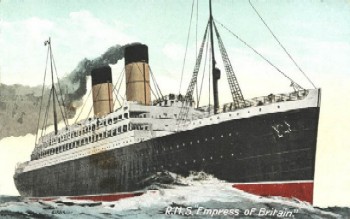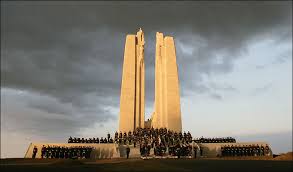My grandfather had a very eventful journey through the First World War. He joined the Canadian Army on June 12th 1916, and fought at Vimy Ridge, Passchaendale and the Somme. The highlight, though, was when he married his childhood sweetheart, on July 15th 1917, I am writing this account on his 97th wedding anniversary.
Will has left an enormous amount of material behind him, including a piece of German shrapnel, his leather dog tags, and a piece of camouflaged fabric he cut off the wing of a German aircraft which had crashed in front of him in no-man’s-land.
He was, as can be judged from the surviving photographs, a hard man. He was one of what must have been the thousands of impoverished Englishmen who all set off to make their fortune in the distant reaches of the British Empire
He lived at 266, Symington Avenue, Toronto.
He was employed as a locomotive fireman on an enormous Canadian Pacific Railways train, number 2528, which ran between Chapleau, Ontario, right across the Great Plains to Winnipeg. In this picture, Will is actually in the cab of the giant locomotive…
Will was to join the Canadian Army at the Toronto Recruiting Depot on June 12th 1916. He weighed 123½ pounds, and was considered by Captain J.W.Barton to be fit enough to join the Canadian Over-Seas Expeditionary Force.
On July 6th 1916, he made a will, witnessed by the Orderly Room clerks, Messrs Irving and Smith. Judging by the small print, this document was eventually to make Mrs Mary Atkins of 999, High Street, Aldershot, a very rich woman indeed, particularly after the Battle of the Somme.
Will sailed from Canada to the Western Front on July 16th 1916 on the “S.S.Empress of Britain”.
On July 25th, he arrived in England, and was taken on strength at Shorecliffe in Kent. On November 23rd 1916, he arrived in France and went straight into the 69th Overseas Battery of the Canadian Field Artillery, where he was eventually to become a Gunner.
In the early part of his military career, Will seems to have earned some fifteen Canadian dollars per month, which then appears to have risen eventually to thirty dollars in 1917 and 1918. Perhaps the most significant event in Will’s war service was being given permission to marry, back in the sunny and rather more safe, South Derbyshire. The happy day was July 15th 1917…
When I was a boy, my grandfather spoke to me not of wedding dresses, though, but of events in the war. He talked of having fought at Bapaume, at either Pozières Wood or Polygon Wood, and above all, at Vimy Ridge.
Canadian author Pierre Burton writes wonderfully of
“…soldiers, trapped in the horrors of a silly and senseless war and enduring almost indescribable conditions”.
But at the same time, it was the day when a fledgling nation came of age, when a colony became an independent nation……
“On a chill Easter Monday in 1917, with a blizzard blowing in their faces, the four divisions of the Canadian Corps in France did what neither the British, nor the French armies had been able to do in more than two years of fighting.
They seized and held the best-defended German bastion on the Western Front – a muddy scarp known as the Vimy Ridge. The French, who had lost 150,000 men trying to take the ridge, didn’t believe it could be done. Nor did the Germans; even the British were sceptical. But the Canadians triumphed!
They went over the top at dawn. By lunchtime, most of the ridge was in their hands – at a cost of ten thousand casualties. ” (Pierre Burton)
This is the Canadian Memorial, at the top of the ridge…
Will was certainly a veteran of Passchendaele in 1917, and in 1918, I believe, fought in the Somme area where blood soaked battles had taken place some two years earlier….
In later life, of course, Will was to become profoundly deaf. It is tempting to think that the very first steps in this unfortunate process began with the enormous volume of noise he must have experienced in the Canadian artillery during the First World War.
Will finally left France for the last time, and proceeded to England, via the French port of Le Havre. He was finally discharged from the army on May 23rd 1919.
From his medical examination, he had put on some sixteen pounds during his time in the army, and now weighed a hundred and forty pounds, a glowing testimony to the quality of the food in the Canadian Over-Seas Expeditionary Force. He had also apparently grown half an inch taller.
Still, at least Will did actually come back home safe and sound. It was not a speedy process, however. It was six months before he was no longer a soldier.
On March 4th and 5th 1919, at Kinmel Park in Denbighshire, north Wales, Canadian troops had rioted against their dreadful living conditions, sick of the constant, apparently pointless delays, and longing to be allowed to go home at last back to their families in Canada. The rioters were fired upon by British troops.
Five brave Canadians were killed and 23 were wounded. It was one of 13 mutinous riots by Canadian troops, all for exactly that same reason.
Records of Canadian soldiers in the First World War can be accessed online at the Library and Archives Canada website.
For my grandfather, two pages are viewable. I know from my own experience, though, that if you pay your money, you will have access to page after page of extremely interesting material.




















